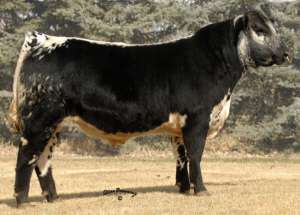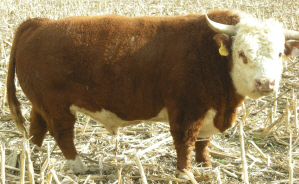



Bazadaise
History
The Bazadaise (pronounced Baz-A-Day) originates from France and the historic town of Bazas, where a Herd Book was established in 1895.From the Gironde area through the lowlands of the Landes to the Haute Pyrenees (summering on mountain pastures up to 2400m high (7200ft), this former working breed with its hardiness and resilience, endurance to cold and heat, a seemingly natural resistance to ticks and flies, the Bazadaise is a proven adaptable and hardy breed.
 Photo courtesy of Goose Green Farm, www.goosegreenfarm.com |
Today the Bazadaise is very much a superior beef breed renowned for its grass finishing ability, mobility, extended muscle and ease of calving and gaining a worldwide reputation for the fine flavoured low fat and well marbled meat. (Achieving in France the coveted 'Label Rouge' label in 1997)
Characteristics
Bazadaise range in colour from dark to light grey with the eyes, muzzle and mucous membranes being pale and clear. They have tough horns and the hoofs are small and dark. Average height and weight of Bazadaise bulls are 145cm and 1100kg, the cows 140cm and 750kg. Calves are born a pale beige colour and remain so until about 3 months old.Bazadaise have exceptional length with excellent conformation, good muscular development with a broad back and a well-rounded rump. A fine bone structure produces exceptional yields as a pure or crossbred.
Bazadaise make excellent mothers with more than 70% of the cows having a calving interval of less than 380 days. The calves are small 35 - 42kg, alert and mobile soon after birth. The muscle development becomes visible at 10 to 14 days.
A natural grazer, the Bazadaise is suited to any method of production with weights of 500 kilo achievable at 12-14 months. The consistently high standard of conformation leading to higher carcass classifications has led to animals topping the market around the country, killing out at 63-67% at the higher end of the evaluation scale, (E/U). Use of the Bazadaise on the Dairy herd, especially on heifers is proving very successful. From the Holstein the calves are predominately black, becoming sought after as suckler replacements and the steers being marketed for good quality beef production.
Statistics
 Photo courtesy of Goose Green Farm, www.goosegreenfarm.com |
Comparative
Distribution
The Bazadaise can be found in France, England, Australia, Belgium, Spain and Holland.References (the above information was cited from the following sites)
www.bazadaise.org.uk
www.bazadaisaustralia.com
www.bazadaise.com.au
www.goosegreenfarm.com


